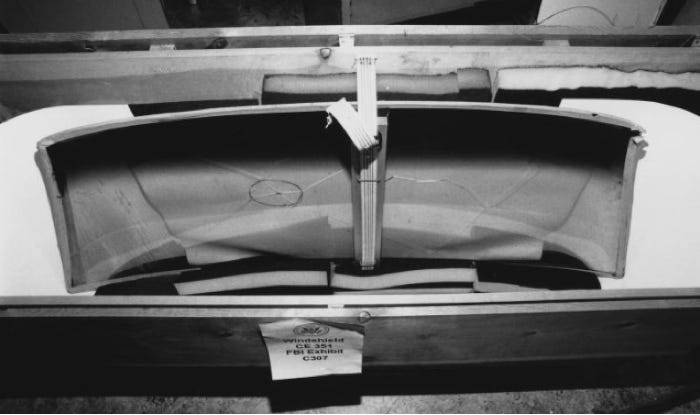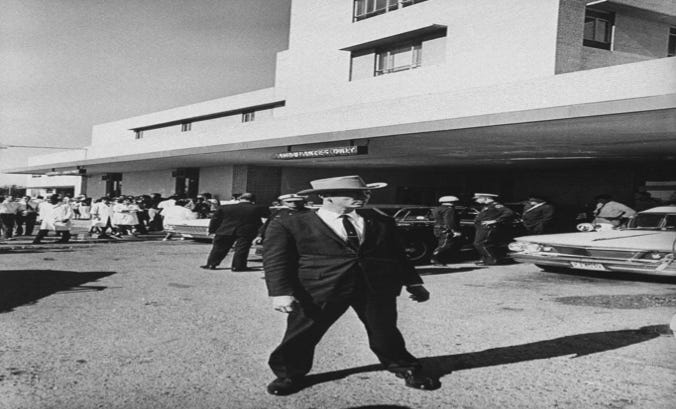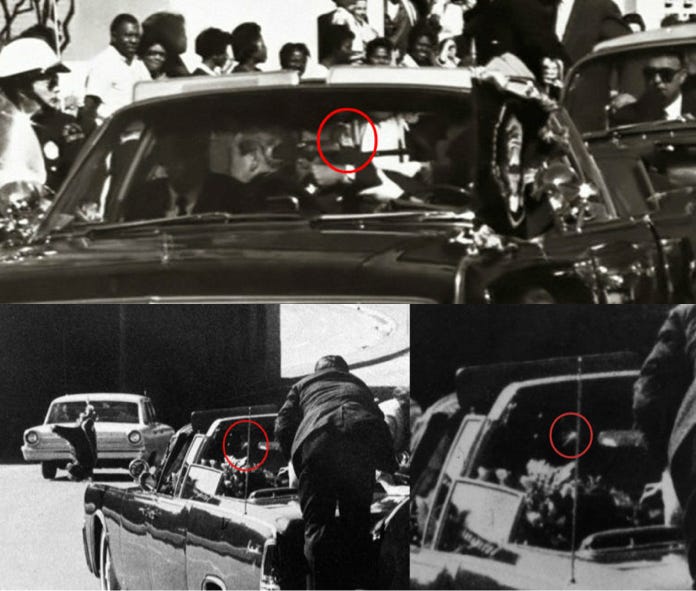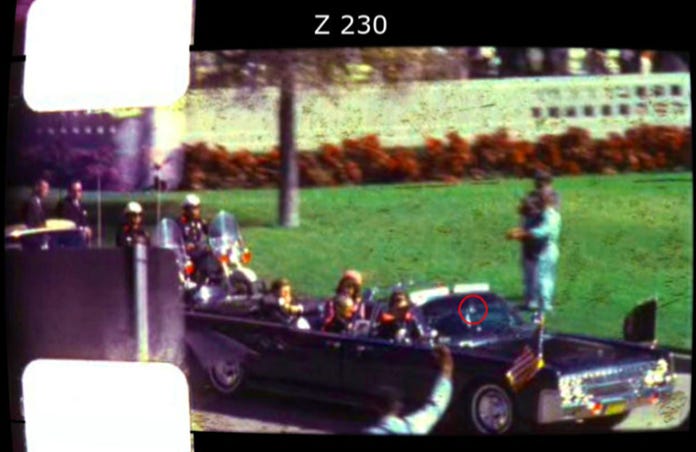You are using an out of date browser. It may not display this or other websites correctly.
You should upgrade or use an alternative browser.
You should upgrade or use an alternative browser.
On this day in 1963, President Kennedy was shot and killed in Dallas, Texas
- Thread starter Enfuego
- Start date
Such a fascinating event in regards to all the circumstances surrounding it. The conspiracy, investigations, recreations, the film. He was the last conservative leaning Democrat that ever existed. Keep the eternal flame burning.
I'd argue that he was further to the right than 90% of the Republicans out there today.
90% of ALL CONSERVATIVES were Democrats until Barry Goldwater and you figure it out - what happened then? Boy, people are Stupid ( not you HamGlaze), just people don’t like to use what a God gave ‘em. We are all dupes! Dems were Conservatives - Republicans were Liberals and then , well, you figure it out! Bullies are Bullies whatever channel you watch! Good Luck Crackers! Your Days are numbered - Thank God!Such a fascinating event in regards to all the circumstances surrounding it. The conspiracy, investigations, recreations, the film. He was the last conservative leaning Democrat that ever existed. Keep the eternal flame burning.
90% of ALL CONSERVATIVES were Democrats until Barry Goldwater and you figure it out - what happened then? Boy, people are Stupid ( not you HamGlaze), just people don’t like to use what a God gave ‘em. We are all dupes! Dems were Conservatives - Republicans were Liberals and then , well, you figure it out! Bullies are Bullies whatever channel you watch! Good Luck Crackers! Your Days are numbered - Thank God!
I love to laugh, thank you
And Republicans have always been the most conservative party, but I doubt you really know what the definition of a conservative or liberal is. It's obvious you don't know anything about policy, you actually think it's about race
Just thank the crackers some day, for feeding you
RIP JFK.
It was a better country then.
He was the last President to serve over a country that basically all shared the same values, self determination, hard work, self reliance, honesty, patriotism, bravery, courage, all guided by the hand of God through Judeo Christian beliefs.
I would argue that the Vietnam (war of containment) War and LBJ's Great Society vision (welfare) and policy implementation, and later the pedophile scandals that rocked the Catholic Church, changed the country forever. And not for the better.
It was a better country then.
He was the last President to serve over a country that basically all shared the same values, self determination, hard work, self reliance, honesty, patriotism, bravery, courage, all guided by the hand of God through Judeo Christian beliefs.
I would argue that the Vietnam (war of containment) War and LBJ's Great Society vision (welfare) and policy implementation, and later the pedophile scandals that rocked the Catholic Church, changed the country forever. And not for the better.
Jimmy Carter is not a liberal. He's a Sunday school preacher and is a democrat in bad health. A Naval Academy graduate with a degree in physics..a farmer and our oldest living President! Good decent man
Carter is a flaming liberal who does not have a degree in physics, that is a lie. Carter got a general Bachelors Degree with no concentration in anything. He's a
Jew hater that supports terrorist organizations like Hamas. He is also the 2nd worst President in history, to Obama.
Dershowitz: Carter has the blood of thousands on his hands:
https://www.newsmax.com/Newsmax-Tv/Dershowitz-Carter-Abe-Foxman-Israel/2015/01/14/id/618557/
Carter is a flaming liberal who does not have a degree in physics, that is a lie. Carter got a general Bachelors Degree with no concentration in anything. He's a
Jew hater that supports terrorist organizations like Hamas. He is also the 2nd worst President in history, to Obama.
Dershowitz: Carter has the blood of thousands on his hands:
https://www.newsmax.com/Newsmax-Tv/Dershowitz-Carter-Abe-Foxman-Israel/2015/01/14/id/618557/
Pardon me on the physics...I listened to him on a TV interview many ago and maybe I got that one wrong. But this I did not get wrong, He is a Naval Academy graduated from the top 10% of his graduating class. I believe 5th was the number he graduated in his class. And THIS I guarantee I did not get wrong. I grew up poor as a chrch mouse with a dad as a farmer that worked from before dusk until dawn and a mom that did what she could And THIS I DID NOT WRONG..I worked for the US DEPT of Agriculture and it wasn't any gravy job. My group was invited to visit the Carter peanut farm when he was in office and a convention was held in Albany Ga. --Near Plains, Ga. Met his mom and brother, they could not have Been nicer to just old country boys that grew up mostly with an Ag background! You don't teach Bible classes at a Southern Baptist Church, get down on your hands and knees to hammer nails to build shelter to help others and be called a Liberal. But have a Happy Thanksgiving and a Merry Christmas!
RIP JFK.
It was a better country then.
He was the last President to serve over a country that basically all shared the same values, self determination, hard work, self reliance, honesty, patriotism, bravery, courage, all guided by the hand of God through Judeo Christian beliefs.
I would argue that the Vietnam (war of containment) War and LBJ's Great Society vision (welfare) and policy implementation, and later the pedophile scandals that rocked the Catholic Church, changed the country forever. And not for the better.
Keep teaching your children that America has been all downhill since the early 1960s.
We will keep teaching ours that it has never been better to be living in the USA and it will continue to get even more awesome
Thank You Willie ( I am hungry ! )I love to laugh, thank you
And Republicans have always been the most conservative party, but I doubt you really know what the definition of a conservative or liberal is. It's obvious you don't know anything about policy, you actually think it's about race
Just thank the crackers some day, for feeding you
Thomas Lipscomb: Hidden In Plain Sight
The Key To The Kennedy Assassination Is On Public Display In The National Archives

| Emerald Robinson
|
NOTE: The renowned journalist Thomas Lipscomb has just completed a new manuscript (with Jerome Kroth) titled The Oswald Letter and it contains a number of staggering claims based on these federally released documents as well as fresh accounts from new eyewitnesses who have never before been interviewed. This is the third excerpt from The Oswald Letter to appear here on my Substack.
According to the catalog listing of the National Archives in Washington, this is the “Windshield Removed from the Presidential Limousine that Carried President John F. Kennedy During the Assassination.” It is still carrying its FBI evidence tab.

But is it?
The Secret Service had the Presidential limousine shipped from Dallas to the White House garage the night of the assassination. Then they sent it to the Ford Factory at River Rouge in Detroit, where it was built, for refitting.
When a senior manager there, George S. Whitaker, came to work two days after the assassination, he was ordered to immediately report to the glass plant lab. He was let in through locked doors and found two of his men had already removed the limousine windshield.
As Whitaker said in a recorded interview: “And the windshield had a bullet hole in it, coming from the outside through…it was a good, clean bullet hole, right straight through, from the front. And you can tell, when the bullet hits the windshield, like when you hit a rock or something, what happens? The back chips out and the front may just have a pinhole in it…this had a clean round hole in the front and fragmentation coming out the back.”
In an interview a few months later he added: “The hole was about 4 or 6 inches to the right of the rear view mirror [as viewed from the front]. The impact had come from the front of the windshield. If you have spent 40 years in the glass [illegible] you know which way the impact was from.”
Following their orders, Whitaker had his men use the old windshield as a template, create and install a new one, and then once again following orders, they ground up and destroyed the original windshield with the bullet hole in it. The refurbished limousine was then sent back to the Secret Service in Washington.
Whitaker is far from the only witness who saw a bullet hole in the windshield. Several members of the Dallas Police, a nurse, and several doctors (and others) at Parkland Hospital noticed it when it was still parked outside while doctors were trying to save Kennedy. One motorcycle patrolman was quite specific: “There was a hole in the left front windshield…It was a hole, you could put a pencil through it…you could take a regular standard writing pencil…and stick [it] through there.”

Dallas Motorcycle Patrolman inspecting limo windshield at Parkland
None were called as witnesses by the Warren Commission.
The Warren Commission finding? “The windshield was not penetrated by any bullet. A small residue of lead was found on the inside surface of the windshield; on the outside of the windshield was a very small pattern of cracks immediately in front of the lead residue on the inside. The bullet from which this lead residue came was probably one of those that struck the President and therefore came from overhead and to the rear. Experts established that the abrasion in the windshield came from impact on the inside of the glass.”
To make this clear, the windshield in the photo (on display at the National Archives today) has a small black circle on the left side. Blown up by the National Archives, the area looks like this:

It certainly doesn’t look at all like Whitaker’s bullet hole. Or what a young medical student at Parkland described. She said: “No way there’s even any cracks associated with that bullet hole, It seemed like a high velocity bullet that had penetrated from front to back in that glass pane” A St. Louis Post Dispatch reporter saw it and said: ““A few of us noted the hole in the windshield when the limousine was standing at the emergency entrance after the President had been carried inside.”
Even a Secret Service agent reported to his boss after inspecting the limousine in the White House Garage, after it had been flown back from Dallas on the day of the assassination: “In addition, of particular note was the small hole just left of center in the windshield from which what appeared to be bullet fragments were removed.”
Most tellingly, some of the first photos taken during the assassination by professionals like Ike Altgens of the Associated Press and even amateurs like Muchmore have this common disfigurement on the same place on the windshield that doesn’t look at all like the cracks on the windshield in the National Archive. In fact they look more like — a bullet hole.

Here are two of Altgens’ photos taken about a second and a half after the first bullet hit President Kennedy. Notice the circle.
All factions to the never-ending argument about who killed Kennedy agree that the first shot hit the President as his limousine passed behind a Stemmons Freeway sign, which temporarily obscured it from the Zapruder film.
But in Zapruder frame 230, the limo emerges with Kennedy clutching his throat from the effects of the first shot. He’s been hit. The Warren Report details Oswald’s two hits for his three shots. All of them came from behind the limousine from Oswald’s “sniper’s nest” up on the 6th floor of the Dallas School Book Depository.
The first shot missed and nicked a bystander with a piece of the bullet or pavement. The first shot that hit Kennedy where he is clutching his throat, shown in frame 230, is the one the Commission claims was “the magic bullet.” This bullet, we were assured, entered Kennedy’s back, exited his throat and went into Governor John Connelly’s back then down his arm, shattering his wrist, and ended up in his thigh. The final bullet fired was the fatal headshot.
But there in frame 230, in the Zapruder film as well as the Altgens, is that white spec on the left side of the windshield, in exactly the same place in all photos. It doesn’t take a ballistics genius to see, just looking at the Zapruder frame, that if one draws a straight line to the place Kennedy is clutching his throat to the white spec on the windshield — and it IS a bullet hole, just as so many witnesses have said, the line of fire extends to the FRONT of the limousine. And that means the first shot to hit Kennedy came from in front of him.
And in that one discovery it becomes clear why the windshield with the bullet hole was destroyed, why the witnesses were disregarded, and why the phony windshield was put on exhibit in the Archives. The Federal Government was destroying evidence that would impeach the findings it wanted produced and faking the evidence it wanted seen. It claimed only two bullets hit Kennedy, both from the rear from Oswald on the 6th floor. But if the first bullet came from the front, what about the second bullet? And Whitaker was ordered to destroy the windshield on the day of Kennedy’s funeral. The Warren Commission hadn’t even been created yet.

Ten years ago a privately printed book came out by a remarkable Certified Senior Crime Scene Analyst named Sherry Feister. She had been working in crime scene investigation and crime scene reconstruction for 30 years. The Federal Government could destroy the original windshield with the bullet hole, but it couldn’t destroy those photos and records of witnesses, and Feister knew just what to look for and what to do with them when she found them. She had done it all her life with many a crime scene.
To make this clear, the windshield in the photo (on display at the National Archives today) has a small black circle on the left side. Blown up by the National Archives, the area looks like this:

It certainly doesn’t look at all like Whitaker’s bullet hole. Or what a young medical student at Parkland described. She said: “No way there’s even any cracks associated with that bullet hole, It seemed like a high velocity bullet that had penetrated from front to back in that glass pane” A St. Louis Post Dispatch reporter saw it and said: ““A few of us noted the hole in the windshield when the limousine was standing at the emergency entrance after the President had been carried inside.”
Even a Secret Service agent reported to his boss after inspecting the limousine in the White House Garage, after it had been flown back from Dallas on the day of the assassination: “In addition, of particular note was the small hole just left of center in the windshield from which what appeared to be bullet fragments were removed.”
Most tellingly, some of the first photos taken during the assassination by professionals like Ike Altgens of the Associated Press and even amateurs like Muchmore have this common disfigurement on the same place on the windshield that doesn’t look at all like the cracks on the windshield in the National Archive. In fact they look more like — a bullet hole.

Here are two of Altgens’ photos taken about a second and a half after the first bullet hit President Kennedy. Notice the circle.
All factions to the never-ending argument about who killed Kennedy agree that the first shot hit the President as his limousine passed behind a Stemmons Freeway sign, which temporarily obscured it from the Zapruder film.
But in Zapruder frame 230, the limo emerges with Kennedy clutching his throat from the effects of the first shot. He’s been hit. The Warren Report details Oswald’s two hits for his three shots. All of them came from behind the limousine from Oswald’s “sniper’s nest” up on the 6th floor of the Dallas School Book Depository.
The first shot missed and nicked a bystander with a piece of the bullet or pavement. The first shot that hit Kennedy where he is clutching his throat, shown in frame 230, is the one the Commission claims was “the magic bullet.” This bullet, we were assured, entered Kennedy’s back, exited his throat and went into Governor John Connelly’s back then down his arm, shattering his wrist, and ended up in his thigh. The final bullet fired was the fatal headshot.
But there in frame 230, in the Zapruder film as well as the Altgens, is that white spec on the left side of the windshield, in exactly the same place in all photos. It doesn’t take a ballistics genius to see, just looking at the Zapruder frame, that if one draws a straight line to the place Kennedy is clutching his throat to the white spec on the windshield — and it IS a bullet hole, just as so many witnesses have said, the line of fire extends to the FRONT of the limousine. And that means the first shot to hit Kennedy came from in front of him.
And in that one discovery it becomes clear why the windshield with the bullet hole was destroyed, why the witnesses were disregarded, and why the phony windshield was put on exhibit in the Archives. The Federal Government was destroying evidence that would impeach the findings it wanted produced and faking the evidence it wanted seen. It claimed only two bullets hit Kennedy, both from the rear from Oswald on the 6th floor. But if the first bullet came from the front, what about the second bullet? And Whitaker was ordered to destroy the windshield on the day of Kennedy’s funeral. The Warren Commission hadn’t even been created yet.

Ten years ago a privately printed book came out by a remarkable Certified Senior Crime Scene Analyst named Sherry Feister. She had been working in crime scene investigation and crime scene reconstruction for 30 years. The Federal Government could destroy the original windshield with the bullet hole, but it couldn’t destroy those photos and records of witnesses, and Feister knew just what to look for and what to do with them when she found them. She had done it all her life with many a crime scene.






